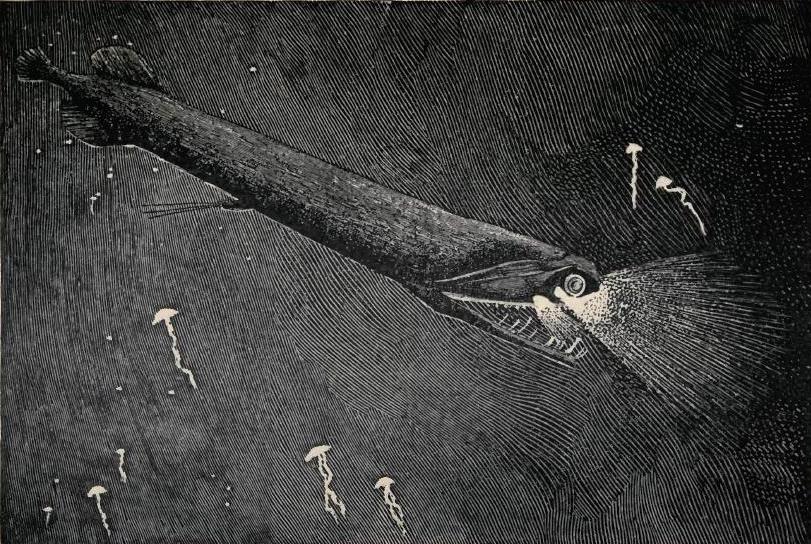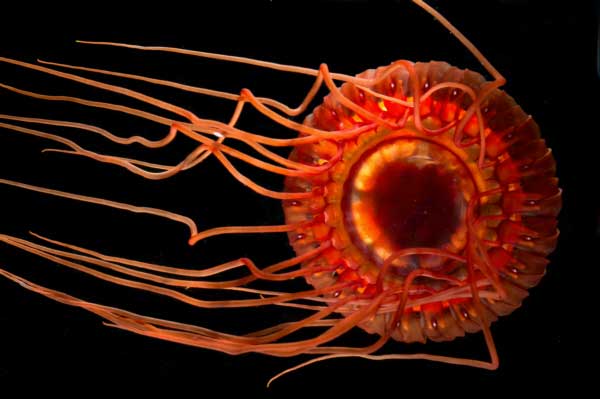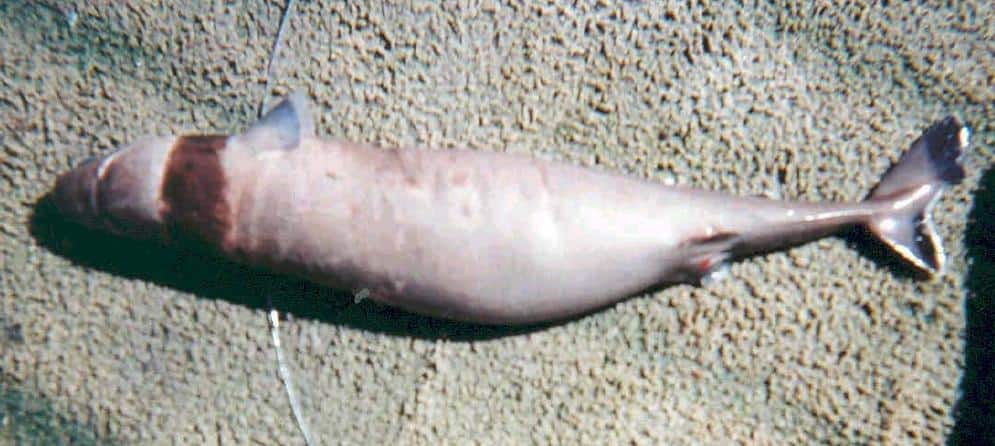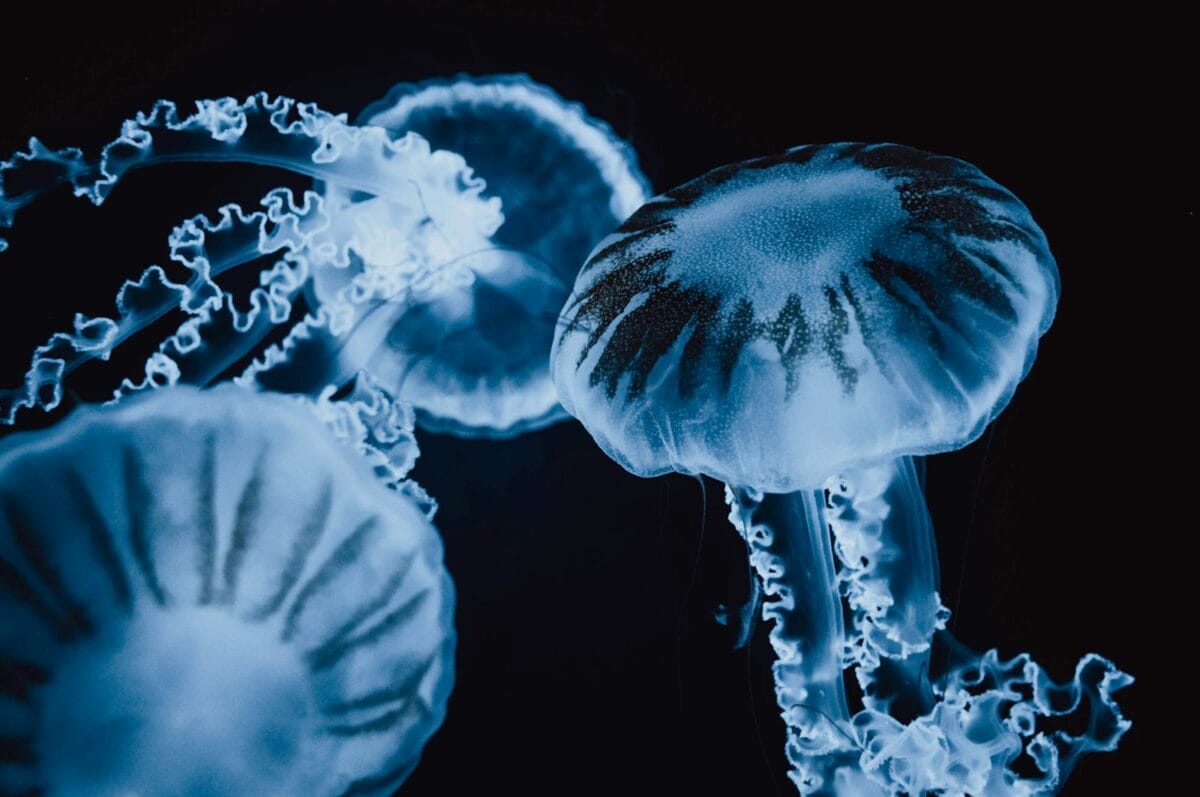The depths of our oceans harbor some of nature’s most spectacular light shows. Bioluminescence—the ability of living organisms to produce light—is a fascinating adaptation that has evolved in numerous marine species. From the deepest trenches to shallow coastal waters, glowing sea creatures illuminate the darkness with their ethereal radiance. This natural phenomenon serves various purposes, from attracting prey and mates to deterring predators. In this article, we’ll explore 13 remarkable sea creatures that have mastered the art of creating their own light, revealing how this magical ability helps them thrive in the mysterious underwater world.
13. The Science Behind Bioluminescence

Bioluminescence is a chemical process where light is produced by a reaction between a compound called luciferin and an enzyme called luciferase. When these substances interact with oxygen, they create a cold light with little to no heat emission. This energy-efficient light production is particularly valuable in the deep sea, where resources are scarce. Different species have evolved varying colors of bioluminescence, with blue-green being the most common as it travels farthest through seawater. Some creatures produce light directly within specialized organs called photophores, while others host symbiotic bacteria that generate light on their behalf. This remarkable adaptation has independently evolved numerous times throughout marine evolutionary history, demonstrating its significant survival value in ocean environments.
12. Anglerfish: The Deep-Sea Predator with a Living Lure

The anglerfish is perhaps the most iconic bioluminescent sea creature, recognizable by the glowing appendage that extends from its forehead like a fishing rod. This modified dorsal spine, called an illicium, hosts colonies of bioluminescent bacteria that emit a haunting blue-green light. Female anglerfish use this natural lure to attract curious prey in the pitch-black depths where they live, often below 3,000 feet. When smaller fish approach the glowing lure, the anglerfish strikes with lightning speed, engulfing victims in its enormous jaws lined with needle-like teeth. Interestingly, the bioluminescent relationship is symbiotic—the bacteria receive nutrients and a safe environment while the anglerfish gains an effective hunting tool. The anglerfish’s extreme sexual dimorphism adds another layer of fascination, with tiny males permanently fusing to females as parasitic mates, ensuring reproduction in the vastness of the deep ocean where finding a mate is extraordinarily challenging.
11. Vampire Squid: Cloaked in Glowing Velvet

Despite its intimidating name, the vampire squid (Vampyroteuthis infernalis, which translates to “vampire squid from hell”) is a gentle deep-sea dweller that bears bioluminescent properties unlike any other cephalopod. Living at depths between 2,000 and 3,000 feet, this ancient creature possesses light-producing organs called photophores scattered across its velvety, reddish-black body. When threatened, the vampire squid executes one of the ocean’s most spectacular defense mechanisms—it can turn its entire cape-like web inside out, revealing rows of glowing blue photophores. This “light show” disorients predators while the squid escapes. Additionally, it can eject a cloud of bioluminescent mucus instead of the typical ink used by other cephalopods, creating a glowing cloud that serves as a distraction. This remarkable 12-inch creature represents a unique evolutionary lineage, being neither a true squid nor an octopus but the sole surviving member of the order Vampyromorphida, which has existed for over 300 million years.
10. Crystal Jellyfish: Nature’s Living Light Bulb

The crystal jellyfish (Aequorea victoria) might appear plain in daylight, but in darkness, it transforms into a mesmerizing display of bioluminescent beauty. Native to the Pacific coast of North America, this transparent jellyfish produces blue-green light along the edge of its bell using a compound called aequorin that interacts with calcium ions. What makes this species particularly significant is that scientists isolated the green fluorescent protein (GFP) from it, which revolutionized biomedical research. For this groundbreaking discovery, researchers were awarded the 2008 Nobel Prize in Chemistry. GFP is now widely used as a marker to track protein expression and cellular processes in living organisms. In their natural habitat, crystal jellyfish use their glow to startle predators and potentially to attract prey. Their translucent bodies allow the light to diffuse beautifully, creating a ghostly glow that pulses with the jellyfish’s movements as it drifts through the water column.
9. Flashlight Fish: Nature’s Underwater Headlamps

The flashlight fish (family Anomalopidae) possess one of the most distinctive bioluminescent adaptations in the ocean. Below each eye, these remarkable fish harbor bean-shaped organs filled with bioluminescent bacteria that produce a steady blue-green glow. Unlike many deep-sea creatures, flashlight fish typically inhabit relatively shallow reef environments but remain active primarily at night. Their light organs function like controllable headlamps; the fish can rotate the organs or cover them with specialized eyelid-like structures, effectively creating a blinking pattern. This blinking serves multiple purposes: it helps the fish form schools in darkness, attracts plankton for feeding, confuses predators, and enables communication with potential mates. Some species, like Photoblepharon palpebratum, use synchronized blinking patterns within schools to create confusion for predators—a strategy called “blink-and-run.” The symbiotic bacteria receive oxygen and nutrients from the fish’s bloodstream in exchange for their luminous services, representing one of nature’s most successful partnerships.
8. Comb Jellies: Rainbow Light Displays

Comb jellies, or ctenophores, present one of the ocean’s most enchanting light displays. Unlike true jellyfish, these ancient creatures belong to a distinct phylum and possess rows of cilia (tiny, hair-like structures) that propel them through the water. These cilia diffract light like prisms, creating rainbow-like patterns even in daylight. However, many species of comb jellies also produce true bioluminescence, most commonly in blue or green hues. When disturbed, they can emit waves of light that travel along their bodies, creating a spectacular rippling effect. The Beroe forskalii, a predatory comb jelly, flashes brightly when it captures prey, possibly to deter other predators from stealing its meal. Another species, Mnemiopsis leidyi, produces light when stressed, using the flash to startle potential predators. Comb jellies are among the earliest branching animal lineages, having diverged from other animals over 550 million years ago, making their bioluminescent capabilities one of the earliest examples of light production in the animal kingdom.
7. Lanternfish: Illuminating the Mesopelagic Zone

Lanternfish (family Myctophidae) may be small—typically measuring less than six inches—but they constitute approximately 65% of all deep-sea fish biomass, making them among the most abundant vertebrates on the planet. These remarkable fish inhabit the mesopelagic zone (650-3,300 feet deep) and possess complex patterns of photophores along their undersides, sides, and heads. These light-producing organs can be species-specific in their arrangement, almost like a bioluminescent fingerprint. Lanternfish use their lights for counterillumination, a camouflage technique that helps them match the faint sunlight filtering from above, concealing their silhouettes from predators lurking below. Additionally, their distinctive light patterns aid in species recognition and courtship in the darkness. Most lanternfish participate in diel vertical migration—the largest daily animal migration on Earth—where they ascend to feed in productive surface waters at night and descend to darker depths during the day to avoid predators. This migration plays a crucial role in the ocean’s carbon cycle, as lanternfish transport carbon from surface waters to the deep sea.
6. Dinoflagellates: Microscopic Light Shows

Among the smallest bioluminescent organisms in the ocean, dinoflagellates create some of the most spectacular displays. These single-celled protists can bloom in massive numbers, creating the phenomenon known as “sea sparkle” or “burning seas,” where water appears to glow blue when disturbed. Species like Noctiluca scintillans react to mechanical stimulation by producing a brief flash of blue light, lighting up when waves break, boats pass through, or swimmers move through the water. This defensive adaptation likely evolved to startle predators or attract the attention of secondary predators that might threaten the organisms feeding on the dinoflagellates. The biochemical mechanism involves a protein called dinoflagellate luciferase that reacts with oxygen and a substrate called luciferin when the cell is physically disturbed. The resulting light reaction occurs within specialized organelles called scintillons. These tiny organisms have significant ecological impacts; some species produce red tides associated with harmful algal blooms, while their bioluminescent properties have inspired applications in biotechnology, including as biological sensors and in developing more efficient lighting systems.
5. Stoplight Loosejaw Dragonfish: The Triple-Light Predator

The stoplight loosejaw dragonfish (Malacosteus niger) represents one of the most sophisticated bioluminescent systems in the ocean. This fearsome predator, dwelling at depths of 1,600-3,300 feet, possesses three different types of light-producing capabilities. Most distinctively, it can produce red light—extremely rare in marine bioluminescence because red light is quickly absorbed in water. This red light acts as a kind of “private spotlight” that the dragonfish can see but most other deep-sea creatures cannot detect, giving it a significant hunting advantage. Additionally, it produces the more common blue light from photophores along its body and a green light near its eyes. The fish’s “loosejaw” refers to its modified jaw structure that can rapidly extend to capture prey spotted with its red searchlight. To produce red light, the stoplight loosejaw has independently evolved a unique biological mechanism that converts blue light to red using a specialized pigment derived from chlorophyll—a remarkable case of a non-photosynthetic animal utilizing a plant pigment. This sophisticated triple-light system makes the stoplight loosejaw one of the most specialized bioluminescent hunters in the deep sea.
4. Sea Pens: Colonial Bioluminescent Gardens

Sea pens present some of the most elegant displays of bioluminescence in the ocean. These colonial cnidarians, related to corals and sea anemones, derive their name from their resemblance to antique quill pens. A sea pen consists of a primary polyp (the stalk) with secondary polyps branching off to form feather-like structures. When disturbed, sea pens can produce waves of blue-green light that travel along their branches in mesmerizing patterns. This coordinated light show serves as a defense mechanism—startling potential predators and possibly attracting larger animals that might prey on the sea pen’s attackers. Each individual polyp in the colony contains light-producing cells that can be triggered in sequence, creating the wavelike effect. Species like Renilla reniformis (sea pansy) have become important research organisms for studying bioluminescence. These ancient animals have existed for at least 500 million years, with fossils dating back to the Cambrian period. Sea pens typically inhabit soft-bottom areas from shallow waters to depths exceeding 20,000 feet, remaining partially buried in sediment with their luminous feeding structures extended into the water column.
3. Atolla Jellyfish: The Burglar Alarm of the Deep

The Atolla jellyfish (Atolla wyvillei), sometimes called the coronate medusa, employs one of the most ingenious bioluminescent defense strategies in the deep sea. When attacked, this crimson jellyfish produces a series of intensifying blue light pulses that spiral outward along its perimeter in a dazzling circular pattern. This spectacular display is aptly named the “burglar alarm” strategy—not because it scares away the immediate attacker, but because it attracts larger predators that might prey on the jellyfish’s attacker. Essentially, the Atolla sacrifices its location in hopes that a bigger threat will interrupt the initial predation event, giving it a chance to escape in the confusion. Living at depths between 3,300 and 13,000 feet, this jellyfish features a distinctive trailing tentacle that can be several times longer than its bell diameter (typically 2-6 inches). The Atolla’s transparent bell transitions to a deep red color, which appears black in the deep sea—making its sudden blue light display all the more startling against the dark background. This highly effective strategy has enabled the Atolla to become one of the most abundant jellyfish in the deep ocean.
2. Firefly Squid: Masters of Precision Lighting

Japan’s Toyama Bay becomes the stage for one of nature’s most spectacular light shows when millions of firefly squid (Watasenia scintillans) gather to spawn each spring. These diminutive squid—reaching only three inches in length—possess approximately 5,500 photophores distributed across their bodies, with three larger organs at the tips of each arm. What makes firefly squid extraordinary is their unparalleled control over these light organs. They can produce different colors and intensities simultaneously from various photophores, creating complex patterns of blue light. This precise control serves multiple purposes: counter-illumination for camouflage, communication during mating, and distraction of predators. The squid typically inhabit depths of 600-1,200 feet during the day, rising to surface waters at night to feed. Their annual spawning aggregations in Toyama Bay have become a major tourist attraction and are designated as a Special Natural Monument in Japan. Unlike many bioluminescent creatures, firefly squid produce light through a direct chemical reaction without symbiotic bacteria, giving them more precise control over their light displays than many other marine organisms.
1. Cookie-Cutter Shark: The Glowing Ninja Predator

The cookie-cutter shark (Isistius brasiliensis) employs perhaps the most devious use of bioluminescence in the ocean. This small shark (typically 16-22 inches) has evolved a unique hunting strategy that combines stealth, deception, and bioluminescence. Its body produces a greenish glow through photophores distributed across its underside—except for a dark band around its throat region. When viewed from below against the faint sunlight penetrating from above, this non-luminescent collar creates the illusion of a small fish, attracting larger predators like tuna, dolphins, and even whales. Once the target approaches, the cookie-cutter attaches with its suction-cup lips and specialized teeth, then rotates its body to carve out a perfect plug of flesh—leaving behind the characteristic cookie-cutter wound that gives the shark its name. These sharks inhabit tropical and subtropical waters worldwide at depths of 1,000-3,000 feet, performing vertical migrations to hunt in shallower waters at night. Evidence of cookie-cutter attacks has been documented on various marine mammals, large fish, underwater equipment, and even occasionally on humans. Despite their small size, these sharks’ distinctive bioluminescent hunting strategy makes them one of the ocean’s most specialized predators.
The phenomenon of bioluminescence in marine creatures continues to captivate scientists and ocean enthusiasts alike. Each glowing species represents millions of years of evolutionary adaptation to the unique challenges of ocean life, particularly in the vast darkness of the deep. While we’ve explored thirteen remarkable examples in this article, marine biologists estimate that 80-90% of deep-sea organisms possess some form of bioluminescent capability. As exploration technology advances, researchers continue to discover new species with increasingly sophisticated light-producing mechanisms. Beyond their natural wonder, these organisms provide valuable insights for human applications, from medical imaging and disease detection to developing more efficient lighting technologies. The study of bioluminescence bridges multiple scientific disciplines, including biochemistry, evolutionary biology, ecology, and even astronomy, as scientists search for potential bioluminescent signatures on other water-bearing planets. These remarkable creatures remind us that even in the darkest corners of our planet, life finds extraordinary ways to illuminate the darkness.
- Why This River Suddenly Disappeared—And Scientists Are Stunned - August 20, 2025
- How Some Birds Are Learning to Change Their Songs to Survive in Noisy Cities - August 20, 2025
- 11 Creatures That Don’t Need to Eat - August 20, 2025

